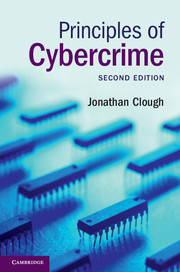Book contents
- Frontmatter
- Contents
- Preface
- Acknowledgements
- Table of Legislation
- Table of Cases
- List of abbreviations
- Part I Introduction
- Part II Computer as target
- 2 Computer as target
- 3 Access offences
- 4 Modification or impairment of data
- 5 Misuse of devices
- 6 Interception of data
- Part III Fraud and related offences
- Part IV Content-related offences
- Part V Offences against the person
- Part VI Jurisdiction
- Bibliography
- Index
6 - Interception of data
from Part II - Computer as target
Published online by Cambridge University Press: 05 October 2015
- Frontmatter
- Contents
- Preface
- Acknowledgements
- Table of Legislation
- Table of Cases
- List of abbreviations
- Part I Introduction
- Part II Computer as target
- 2 Computer as target
- 3 Access offences
- 4 Modification or impairment of data
- 5 Misuse of devices
- 6 Interception of data
- Part III Fraud and related offences
- Part IV Content-related offences
- Part V Offences against the person
- Part VI Jurisdiction
- Bibliography
- Index
Summary
The changing nature of telecommunications
We have seen in previous chapters that offences concerned with unauthorised ‘access’ to a computer evolved to being more generally concerned with the protection of data stored in a computer. In this chapter we consider the next layer of vulnerability: when the data leaves the computer and is communicated to others. The unauthorised uses to which such information may be put are as varied as the communications themselves, but include harassment, extortion, fraud or economic espionage.
Prior to the advent of the internet, mass communication was still dominated by conventional post and telephony. The internet has transformed the way in which we communicate by allowing large amounts of data to be transferred rapidly and easily, throughout the world, at low cost. Emails, short messaging service/multimedia messaging service (SMS/MMS) and instant messaging (IM) are increasingly the preferred modes of personal and business communication. VoIP and similar mechanisms compete with conventional telephony by providing real-time audio and visual communication over the internet. The convergence of technology means that mobile phones are now small networked computers. This increasing connectivity is accompanied by a commensurate increase in opportunities for data to be intercepted.
Offences concerned with the unauthorised interception of communications are not new and are found in each jurisdiction. Such offences have generally evolved from provisions concerned with interception of telephone calls over public telecommunication networks, and many of the challenges which arise have been associated with their application to digital communications. Interception was relatively straightforward when the main form of electronic communication was telephone calls, transmitted over copper wires provided by, at most, a handful of providers. In contrast, in Australia in 2011 there were ‘287 fixed line telephone service providers, three mobile network operators, 176 Voice over Internet Protocol (VoIP) service providers, 33 satellite providers and 97 Internet Service Providers’.
Modern communications may therefore travel over a variety of networks, in different countries and via different media, before reaching their destination. For example, an email sent from a laptop computer or phone may travel via a wireless network to the router where it is sent over telecommunication networks, via a combination of copper lines, optical fibres and radio waves, to the addressee. Internet communications are automatically routed via the most efficient route, and may pass through a number of servers in different jurisdictions en route to their destination.
- Type
- Chapter
- Information
- Principles of Cybercrime , pp. 149 - 206Publisher: Cambridge University PressPrint publication year: 2015



